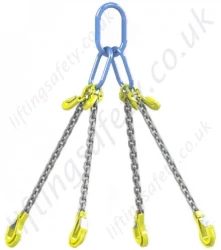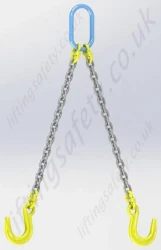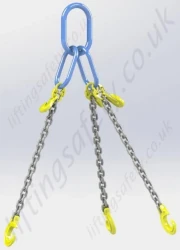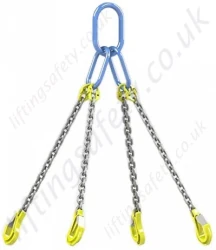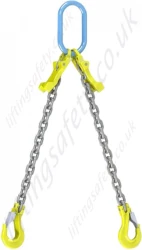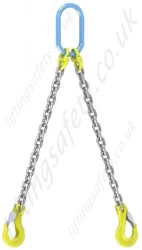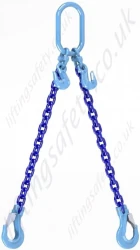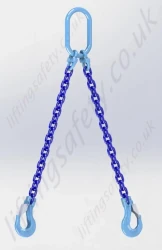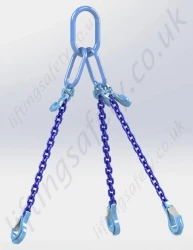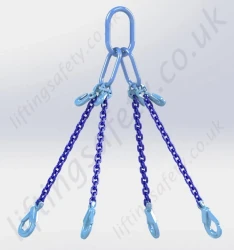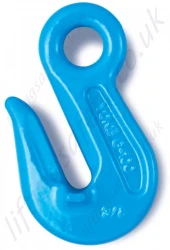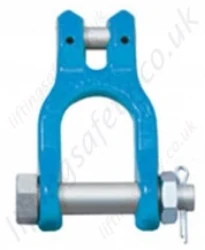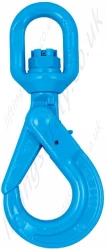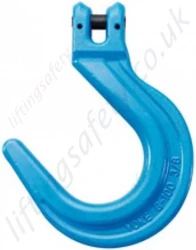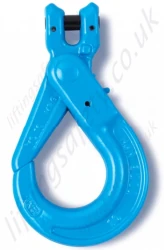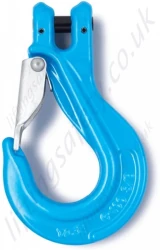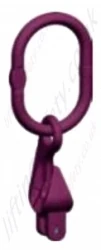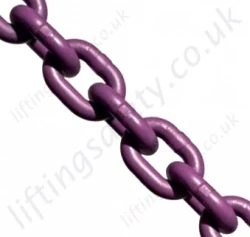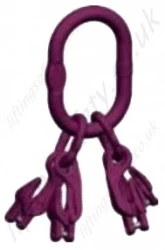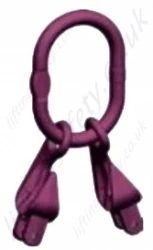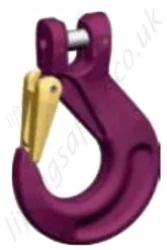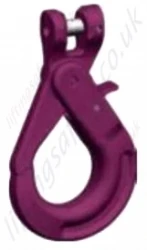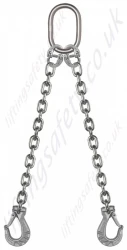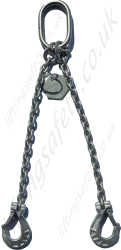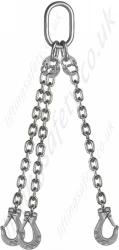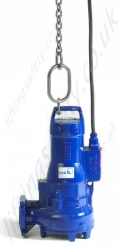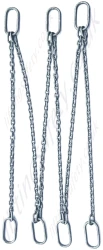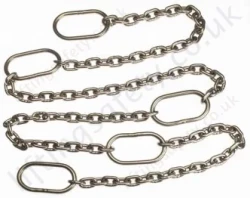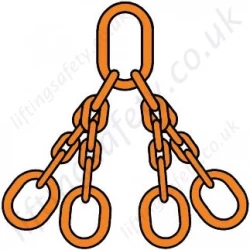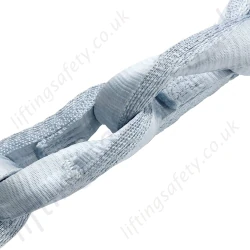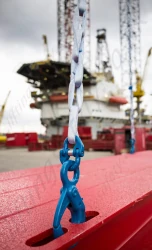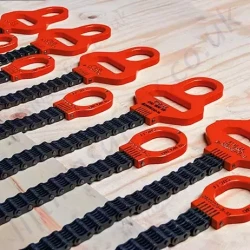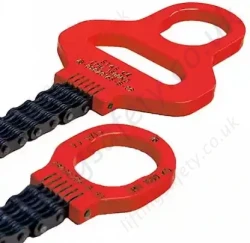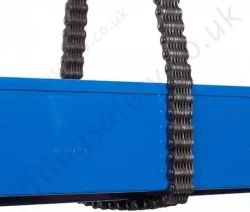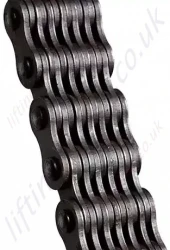Chain Slings for Lifting
In the lifting industry, chain slings can have many other names, including lifting chains, chainslings, and sometimes, Brothers.
Here you can find a full, but not exhaustive, range of lifting chains, manufactured from various grades and types of materials, that are supplied pre-assembled as a chain sling assembly, and they come fully certified, ready to be put straight into service as a part of your lifting equipment arsenal.
Chain Sling Grades
Typically, the most common type and grade of chain sling is grade 8 (also referred to as grade 80). These are the everyday, run-of-the-mill lifting chains. They can be supplied with a variety of different end fittings, such as standard sling hooks (basic latch hook), self-locking hooks (often referred to as safety hooks because of the need to activate a trigger on the back of the hook, which then allows it to open) or clevis shackles, to name a few. Clevis shackles are typically used for those more permanent assemblies. i.e. captivated to a lifting beam.
After grade 8, we then offer grade 10 and grade 12 chain slings (again, as with grade 8/80, grade 10 can be seen referred to as grade 100, and the same with grade 12/120). The key difference and advantage between these 3 grades is the chain size and rated lifting capacity (environmental factors can also benefit through the different grades).
The higher the grade, the higher the capacity to chain diameter ratio, which can often be beneficial to the overall weight of the chain sling. As an example of this, a grade 8, 4-leg chain sling from 16mm lifting chain can be rated with a WLL (working load limit) of up to 17 tonnes, where grade 10 could see a WLL of up to 21 tonnes and grade 12 up to 25.6 tonnes and because the components are all of a similar size, all would have a similar overall weight.
The stainless steel chain assemblies that we offer are more commonly seen to be used in corrosive or food production environments, though they aren't available in the same capacity ranges or with the same array of possible end terminations as grade 8, 10 or 12 steel.
If you are looking for a chain sling that is truly lightweight and that is also flexible, then a Dyneema chain sling might be just what you are looking for. E.g. a Dyneema chain with a WLL of 10.3 tonnes has a self-weight of just 1.2 kg per metre (as a comparison, grade 8 20mm Ø chain rated at 12.5t weighs 9.1 kg per metre. Also worth noting is that a Dyneema chain sling wouldn't necessarily need a permanent hook fitting to connect between a shackle and a load; the shackle could connect directly to the Dyneema chain.
Also available from Lifting Safety is a complete range of individual chain sling components that can be used to build or repair a chain sling assembly.
Shop Chain Slings By Material and Grade
Hack8 Grade 8 Chain Sling
William Hackett grade 8 (80) lifting slings with chain diameters from 7mm to 32mm and WLL's from 1500kg to 67,000kg.
Model: Hack8 Chain Sling System / LCS-2564
Yoke Grade 8 Chain Sling
Grade 8 (80) lifting chain sling assembly manufactured in accordance with EN818-4, 7mm to 32mm chain with WLL up to 67 tonnes. Fitted with RFID tag as standard.
Model: LCS-5541
Yoke grade 80 chain sling assemblies are available in chain sizes starting from 7mm increasing up to 32mm, with capacity ratings starting from 1.5t on a single leg, up to 67 tonne on 3 or 4 leg assembly sets.
Various standard configurations are available; with sling hooks, self-locking hooks etc., but other terminations are also available on request, such as clevis shackles, c-hooks or foundry hooks.
Yoke Grade 10 Chain Sling
Grade 10 (grade 100) chain sling assemblies, 6mm to 32mm, with capacities up to 85 tonne. Lighter in weight by WLL in comparison to Grade 80. RFID equipped.
Model: LCS1-3025
Single Leg Chains, 2 Leg Chains, 3 Leg and 4 Leg Chain slings at any length to suit your application with a shortening clutch fitted for leg length adjustment. We distribute for most reputable manufacturers of chain slings including Crosby, Kuplex, Rud and Pewag so please contact us if you need a quote for any of these chain slings. Our grade 10 chain slings are made to the customers individual specification. We offer a choice of end fitting, many types of lifting hooks and shackles. Grade 80 (gr 8 / GR:80) are also available to purchase online, up to 16mm and high WLL's require a quotation. There is a safety factor of 4 on all grade 10 chain slings.
Grade 12 Lifting Chain Sling
Grade 12 (120) chain slings assembly, 8mm to 16mm and WLL up to 25.6 tonnes. Lighter WLL to weight ratio than grade 8 and grade 10.
Model: CS12-4784
Request QuoteCromox Grade 6 Stainless Steel Chain Sling
Grade 6 (60) stainless steel lifting chain sling assembly, 6mm to 13mm with WLL up to 8.15t. Manufactured in Germany.
Model: CSSL-4576
Request QuoteGalvanised Grade 4 Pump Lifting Chain
Grade 4 (40) high tensile galvanised pump chains with lifting rings at 1 metre centres, 7mm to 26mm with WLL up to 6 tonne.
Model: GPLC-4590
Grade 5 AISI 316L Stainless Steel Pump Lifting Chain
Stainless pump chains with lifting points at 1000mm centres, WLL 500kg to 4000kg.
Model: ASSP-4591
DNV Certified Welded Chain Sling
Welded chain sling asssemblies certified to DNV 2.7-1, type approval number S-5678. and EN 1677-4. 10mm to 20mm diameter, 7.2t to 26.3t WLL
Model: DWCS-3516
Request QuoteWelded chain slings are available in the following sizes:
30° to the vertical: 8000kg, 13,500kg, 20,500kg, 32000kg
45° to the vertical: 6500kg, 11,000kg, 16,500kg, 26,000kg.
Green Pin Tycan Dyneema Lifting Chain
100% Dyneema (synthetic) link chain offering the performance and flexibility of steel chain at a fraction of the Weight. 2.6 to 10.3 tonne WLL.
Model: GPTD-4969
Riveted Chain Wire Mesh Sling
Reevable or Non-reevable (choke) versions, 1.5t to 15t WLL. Standard lengths from 1 to 4 metres.
Model: 421/422/427/428 / RCWM-5524
William Hackett grade 8 (80) lifting slings with chain diameters from 7mm to 32mm and WLL's from 1500kg to 67,000kg.
Grade 8 (80) lifting chain sling assembly manufactured in accordance with EN818-4, 7mm to 32mm chain with WLL up to 67 tonnes. Fitted with RFID tag as standard.
Grade 10 (grade 100) chain sling assemblies, 6mm to 32mm, with capacities up to 85 tonne. Lighter in weight by WLL in comparison to Grade 80. RFID equipped.
Grade 12 (120) chain slings assembly, 8mm to 16mm and WLL up to 25.6 tonnes. Lighter WLL to weight ratio than grade 8 and grade 10.
Grade 6 (60) stainless steel lifting chain sling assembly, 6mm to 13mm with WLL up to 8.15t. Manufactured in Germany.
Grade 4 (40) high tensile galvanised pump chains with lifting rings at 1 metre centres, 7mm to 26mm with WLL up to 6 tonne.
Stainless pump chains with lifting points at 1000mm centres, WLL 500kg to 4000kg.
Welded chain sling asssemblies certified to DNV 2.7-1, type approval number S-5678. and EN 1677-4. 10mm to 20mm diameter, 7.2t to 26.3t WLL
100% Dyneema (synthetic) link chain offering the performance and flexibility of steel chain at a fraction of the Weight. 2.6 to 10.3 tonne WLL.
Reevable or Non-reevable (choke) versions, 1.5t to 15t WLL. Standard lengths from 1 to 4 metres.
Chain Sling – A Heavy-Duty Lifting Solution
What is a Chain Sling?
A chain sling or lifting chain is a robust lifting sling made from high-strength alloy steel chain links, designed for lifting, lowering, and securing heavy loads in industrial environments. Known for their durability, versatility, and resistance to wear, chain slings are widely used in construction, manufacturing, shipbuilding, and logistics.
Types of Chain Slings
Chain slings come in several configurations to suit different lifting needs:
- Single-Leg Lifting Chain - Ideal for straight lifting applications.
- 2 Leg Lifting Chains - Provides greater load stability.
- 3 and 4 Leg Chain Slings - Perfect for complex and unbalanced loads.
- Adjustable Lifting Chains - By means of a shortening clutch or shortening grab hook, it allows flexibility in leg length for varied load sizes (the adjustable factor can be supplied on any of the above-mentioned number of legs).
Each sling can be fitted with different chain sling fittings, such as hooks, shackles, or master links, depending on the lifting task.
Benefits of Using a Chain Sling
- Extreme Strength - Built from alloy steel to handle heavy loads safely.
- Durability - Resistant to abrasion, cutting, and high temperatures.
- Versatility - Suitable for lifting irregularly shaped or unbalanced loads.
- Adjustability - Can be customised to specific lifting requirements.
Chain Sling Safety & Maintenance
To ensure safe operation, always:
- Inspect the chain sling before each use for wear, stretching, or damage.
- Follow the Working Load Limit (WLL) guidelines provided by the manufacturer.
- Store your lifting chains properly to prevent rust and corrosion.
- Replace damaged components immediately.
Common Applications of Lifting Chains
- Construction sites - Lifting beams, rebar, and heavy materials.
- Shipping and ports - Handling cargo and containers.
- Manufacturing plants - Moving machinery parts and large assemblies.
- Mining operations - Hoisting ore, equipment, and materials.
Why Choose a Chain Sling?
A chain sling is a long-lasting, reliable, and cost-effective lifting solution for industries that demand high performance under tough conditions. Whether you need a single-leg chain sling for simple lifts or a multi-leg adjustable sling for complex operations, chain slings deliver strength, safety, and efficiency.
Further Information on Chain Slings
Just follow a few easy steps in selecting your chain sling: Choose either a standard or stainless steel option, then you will see a section headed 'Pricing', from there you can select the desired components, length, diameter of the chain, the lifting capacity (Working Load Limit) that your chain sling needs, along with how many legs the sling requires, and tell us what end fittings and/or shortening clutches are required, all the while, for the standard configurations, you can see the price instantly! As standard, we offer Sling Hooks, Safety Hooks, C Hooks, Foundry Hooks and Clevis Shackles (some configurations may vary depending on SWL and if stainless or standard). Other configurations are available.
Lifting Chain Slings
Standard lifting chain slings are made from Grade 8 (or Grade 80) chains; however, if you would like a quotation for a chain sling with Grade 10 (or Grade 100) chains, don't hesitate to get in touch with our sales team and we will gladly provide a quotation for a Grade 10/100 chain sling to meet your lifting/slinging needs. Grade 100 slings offer a greater safe working load (SWL) for the same size and weight of sling. We offer an excellent choice of pump lifting chains, as often used by water authorities for maintenance and repair of submersible pumps.
Stainless Steel Chain Slings
Our Stainless steel chain slings are made to order, though generally can be made in only a few days from order. Our Grade 5 (50) Stainless lifting assemblies are mainly used in clean environments such as the food industry and are also popular with marine industries due to the corrosion-resistant nature; we now have a dedicated category for corrosion-resistant stainless steel pump lifting chain sling assemblies for use in the water works industries and sewerage works. Stainless steel slings for lifting are usually requested for a special application or in a non-standard environment.
All of our lifting chain slings can be supplied 1 leg (single leg), 2 legs, 3 legs or 4 legs, and all are CE and are issued with a certificate of thorough examination.
Please get in touch with us if you need any help or reassurance in deciding on the correct chain lifting sling to suit your application.
As an alternative to chain slings
We can also supply soft lifting slings in various material types, the most common of which can be bought online here at Lifting Safety. Further to this, we can also supply wire rope slings to your specifications, which have only recently been added to our online catalogue.
Optional Number of Legs / Chains
Here are some examples of chain slings with different numbers of legs. As standard, the number of legs is between 1 and 4, but there are some instances where 5 legs are offered, though this tends to be the DNV-certified type for offshore use.
Single leg chain sling with a standard sling hook
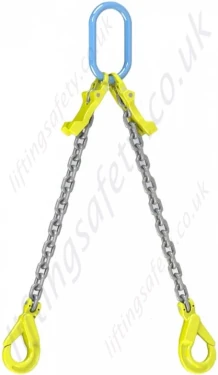
2 legged chain sling with self-locking hooks and chain shortening clutches
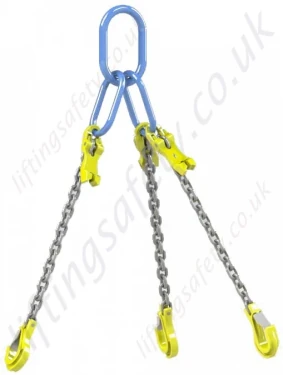
3 legged chain sling with shortening clutches and standard sling hooks
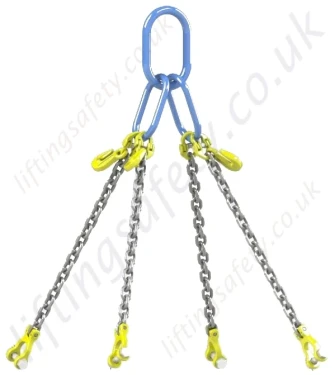
4 legged chain sling with shortening grab hooks and clevis shackles
Proper Use of Chain Slings in the Lifting Industry
Chain slings are essential lifting tools widely used in construction, manufacturing, and other heavy industries due to their strength, durability, and resistance to harsh conditions. However, their safe and effective use requires proper handling, inspection, and understanding of load dynamics.
1. Pre-Use Inspection
Before every lift, visually inspect the chain sling for:
- Cracks, nicks, or gouges in the links
- Bent or stretched components
- Worn components, hooks, connectors, chain, master link, etc.
- Deformation or corrosion
- Damaged tags (a sling must have an identifiable capacity tag to be used)
If any defect is found, the sling must be removed from service immediately and inspected by a qualified person.
2. Choosing the Right Sling
Select the correct type and configuration based on:
- Load weight
- Load shape and size
- Number of lifting points
- Headroom and lifting height
- Sling angle (affects load capacity due to tension changes)

 Common configurations include single-leg, double-leg, triple-leg, and quad-leg slings. The sling angle should ideally be kept between 0° and 45° from the vertical using the Uniform Load Method of Rating from BS EN 818-4 (see example images to the right) to avoid overloading, but in most cases, chain slings are also rated for use with these angles being between 45° and 60°, in which instances, the chain sling capacity or WLL (working load limit) would be reduced/de-rated.
Common configurations include single-leg, double-leg, triple-leg, and quad-leg slings. The sling angle should ideally be kept between 0° and 45° from the vertical using the Uniform Load Method of Rating from BS EN 818-4 (see example images to the right) to avoid overloading, but in most cases, chain slings are also rated for use with these angles being between 45° and 60°, in which instances, the chain sling capacity or WLL (working load limit) would be reduced/de-rated.
3. Safe Lifting Practices
- Position the sling securely around the load using appropriate attachment points; hooks - grade 8 or grade 10 are the most common, shackles, lifting lugs, eye bolts, etc.
- Centre the load to ensure balance and avoid tilting
- Do not twist or knot the chain sling
- Use softeners or edge protectors on sharp corners to prevent damage to the chain and the load
- Lift slowly and steadily to avoid dynamic or shock loading
- Never stand under a suspended load
4. During the Lift
Maintain clear communication between riggers, signalers, and crane operators. Monitor the load for any signs of imbalance, shifting, or abnormal stress during lifting or lowering.
5. Post-Lift Care
After the lift:
- Lower the load carefully and release tension before unhooking
- Inspect the sling again for any damage during the lift
- Clean the sling if it was exposed to chemicals, debris, or moisture
- Store it in a clean, dry, and designated area away from corrosive materials or extreme temperatures


